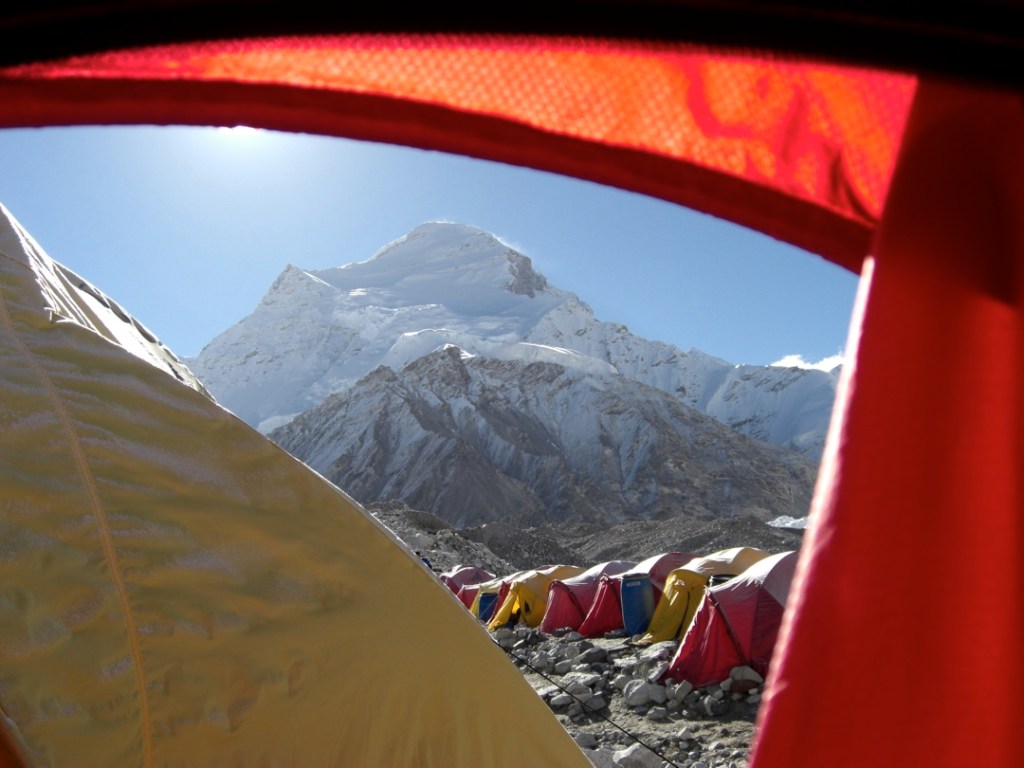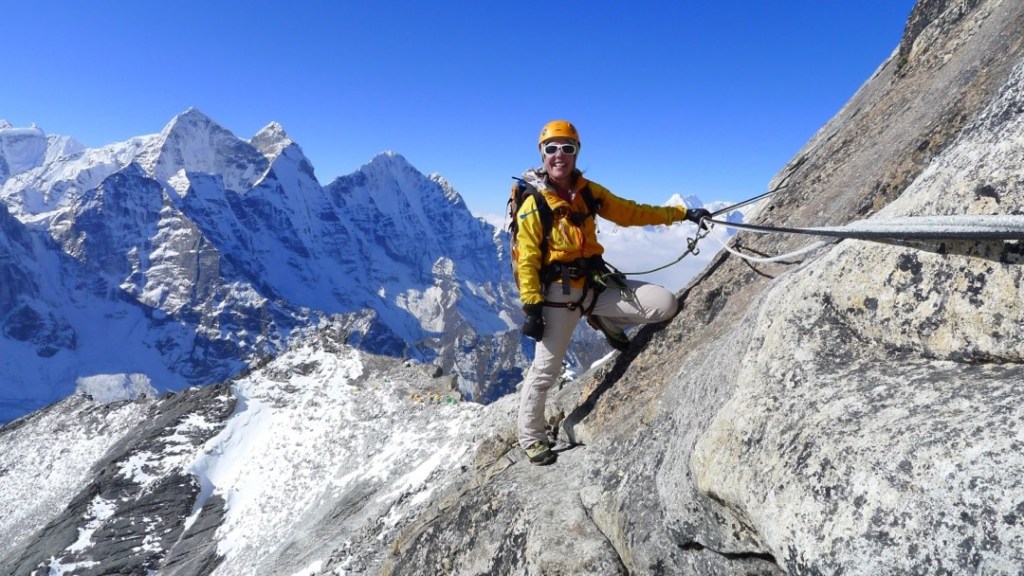There’s no arguing Everest is a place of extremes—that’s exactly what draws many people to the world’s highest peak. At 29,029 feet, it tends to attract a driven person, the type who will push their own limits, says Dr. Monica Piris, expedition team doctor for guide company Alpenglow Expeditions. But high altitude and extreme conditions can throw a curveball to even the most fit, prepared climbers, and that’s exactly why Dr. Piris pays close attention as she monitors teams during their ascents. Deaths and accidents on high altitude peaks may tend to grab headlines, but hundreds of people attempt and succeed to climb Everest each year. In fact, according to climber and Everest-focused journalist Alan Arnette, a record of more than 800 people stood atop the peak in 2018. All the while, doctors like Piris work behind the scenes to make sure things go smoothly for those who climb with the support of a guide company.
Dr. Piris, originally from northern Spain, took up climbing and mountaineering shortly after she became a doctor in 1998. She had moved to New Zealand, where she began to enjoy being in the outdoors. “I started hiking a bit, then hiking a lot,” she says. “Then I did an introductory alpine skills course, and an introduction to rock climbing, and then that was it. Since then I have always loved spending time in the mountains. I cannot stress enough, though, that I am in no way an expert climber or even close! I’m a very low level amateur. I enjoy easy, easy stuff!”
Deciding she wanted to spend more time outdoors than indoors if she could, Dr. Piris pursued a UK Diploma of Mountain Medicine in 2006. “It’s a modular course that you can complete over several years or in one year,” she says. “It’s both practical and theoretical so there are parts of the course conducted in the mountains and other parts that are theory based.” Soon after, she began working on expeditions in 2007. Now she splits time between her home in northern Spain, the French Alps and England—where she works as an emergency medicine physician for five or six days a month but has a zero-hours contract, allowing her flexibility to go on expeditions.
During an expedition she stays at base camp or an advanced base camp, depending on the mountain. Since 2007, she has worked as a doctor for expeditions on Everest, Lhotse, Makalu, Manaslu, Cho Oyo, Ama Dablam, Island Peak and Lobuche in the Himalaya, and Toubkal in the Atlas mountain range of Morocco. She treats climbers as well as locals—in Nepal, the local Sherpas and Nepalis; in Tibet, the Tibetans—for everything from frostbite to upset stomachs, and dispenses advice via radio during rescues of unwell climbers above 8,000 meters (26,247 feet).
Just as climbing at high altitude offers its own challenge, practicing medicine at places like Everest Base Camp—elevation 17,600 feet—or even advanced base camps, thousands of feet higher, isn’t like working at your local doctor’s office. Here’s what Dr. Piris has learned in more than 10 years of working as a high-altitude expedition doctor.

The view from a tent on the way up Cho Oyu—the sixth highest mountain in the world—in the Himalaya.
The thing most people misunderstand: They will never actually feel good at altitudes like Everest base camp or higher.
“People don’t realize that they will never feel like they do at home, that they will have to climb the mountain feeling like shit, but that it’s OK,” says Dr. Piris. After extensive training and preparation, she says it can be difficult for climbers to accept that they’ll feel “subpar, if not downright grim, for most of the trip.”
Previous experience at high altitudes can be very valuable, she says. “Climbers who have been at altitude before are more familiar with the general malaise that is omnipresent at altitude. They know the difference between this general discomfort and the alarming signs of serious illness. Getting that right is imperative.”
On Everest, preventing issues—instead of treating them afterward—is the goal.
“Climbers on the team I work for very rarely have serious, life-threatening conditions because it is my job to avoid that,” says Dr. Piris. Of course, anything that can happen in normal life—like heart attacks, strokes or brain hemorrhages—can happen unexpectedly at high altitude, too, and Dr. Piris has treated all of those on an expedition at some point, she says. But the issues we normally associate with high-altitude climbing—like high-altitude pulmonary edema, high-altitude cerebral edema and frostbite—are all avoidable, she says. “Nobody should die from these conditions.”
Not a fan of sensationalizing, Dr. Piris is cautious when discussing rescues or deaths. “Yes, I have been involved in treating people who have been very ill and subsequently died,” she says. “No, I have never been dangled off a long line from a helicopter to heroically save the life of a stricken climber.”
At base camp, anxiety can make symptoms seem worse than they actually are.
Dr. Piris treats her fair share of coughs, colds and upset stomachs, but she says often there’s a different issue lurking. “People do not feel the same as at home when they are at high altitude,” she says, “And if you do not have experience, it’s easy to be fearful that you are ill. Anxiety and trepidation often make people focus on small physical symptoms and make them a bigger deal than they actually are.”
Part of Dr. Piris’s job is to keep tabs on how the climbers are doing psychologically. “People may become anxious about how they’re feeling, and they are anxious about whether they are going to do well on a climb, so they are looking for reassurance that their symptoms are not something serious,” she says. In times of duress, which expeditions can be, Dr. Piris says, it’s crucial for the least vulnerable person—often the doctor or the guides—to be acutely aware of everything going on for the person who is pushing their limits and is outside their comfort zone. Many people who climb high-altitude peaks are highly motivated and unwilling to show weakness or uncertainty—or even acknowledge its existence, she says. “It’s not my job to point it out, but it is my job to identify it and try to manage it such that it does not become a limiting factor.”

Dr. Piris climbing Ama Dablam in the Khumbu valley of the Nepal Himalaya in 2011.
Talking through whether or not to press on toward a goal is a big part of the job.
Dr. Piris certainly monitors climbers’ physical condition, but a big part of her job is also helping them through their less tangible struggles, like fear and uncertainty.
“If I am confident that a climber doesn’t have a medical reason to desist, I encourage them to try again,” she says. “In climbers who have little experience of high altitude, there is a lot of doubt around how they feel. They don’t know how they should feel and they’re afraid of the fact that they don’t feel like they do at home. If I am satisfied that they are well, then I encourage them to keep trying. I am there to observe and catch any signs of illness, and if there are none, then they can keep trying.”
For a doctor at high altitude, self care is critical.
“Ironically, I am actually not particularly well suited to high altitude,” says Dr. Piris. “I tend to struggle to acclimatize, so one challenge is definitely taking care of myself and making sure I’m well.” When needed, she takes medicine and uses oxygen. “I use headache medication, medication to treat acute mountain sickness, nausea, and if I get a cold, something to relieve the symptoms,” she says. One year, she was so unwell at advanced base camp that she slept on oxygen each night for almost a month, she says.
“I also try and be realistic about what I can do,” she explains. “Like how long it will take me to get from base camp to advanced base camp.” She’s quick to explain that she’s an amateur climber, and that it doesn’t benefit anyone if she tries to push herself and winds up unable to help in a time of need. “I’m most useful giving advice and instructions on the radio when events happen up high, and being prepared to receive an injured or sick climber in a camp where I have the equipment and environment in which I can provide the best care,” she says.
One of a doctor’s toughest challenges at base camp might surprise you.
Aside from struggling to acclimatize, Dr. Piris says one of her biggest challenges is actually interpersonal. Going on an expedition with the intention of trying to climb a high-altitude peak is an unquantifiable privilege available only to very, very few people, she says. “I don’t like it when people complain about it when they get there. Dealing with that is a challenge.” When complainers are beginning to get to her, she says, she tries to diplomatically remind people how privileged they are—how special that extreme environment is. “That ‘harsh environment’ is a stunningly beautiful, wild, magnificent, humbling, and formidable part of our planet,” she says. “It’s a privilege to spend time there.”
